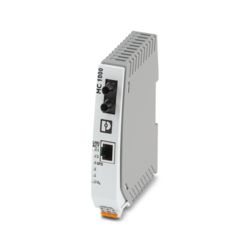
Fiber optic converter with LC duplex connection (1310 nm) for 100Base-TX to multimode fiber optics, DIN rail mountable.


FO media converters for Ethernet and fieldbus enable you to convert your copper interfaces to interference-free fiber optics without the need for complex surge protection, shielding, and equipotential bonding measures.

Fiber optic converter with LC duplex connection (1310 nm) for 100Base-TX to multimode fiber optics, DIN rail mountable.

Fiber optic converter with SC duplex connection (1310 nm) for 100Base-TX to singlemode fiber optics, DIN rail mountable.

Fiber optic converter with ST (B-FOC) connection (1310 nm) for 100Base-TX to multimode fiber optics, DIN rail mountable.

Gigabit fiber optic converter with SC duplex connector (1310 nm) for 1000Base-T to singlemode fiber optics, DIN rail mountable, extended temperature range, redundant power supply, IECEx, ATEX, UL HazLoc, IEC 61850, IEEE 1613, DNV.

Fiber optic converter with SC duplex connection (1310 nm) for 100Base-TX to multimode fiber optics, DIN rail mountable.

FO converter with SC duplex fiber optic connection (1300 nm), for converting 10/100Base-T(X) to single mode fiberglass (9/125 µm). Auto negotiation and auto MDI(X) function. Comprehensive link diagnostics. DIN-rail mountable, 18 ... 30 V DC supply.

FO converter with integrated optical diagnostics, alarm contact, for RS-422/RS-485 4-wire/INTERBUS up to 2 Mbps, terminal device with one FO interface (BFOC), 850 nm, for PCF/fiberglass cable (multimode)

FO converter with integrated optical diagnostics, alarm contact, for RS-485 2-wire bus systems (SUCONET K, MODBUS ...) up to 500 kbps, NRZ coding, termination device with an FO interface (SC-Duplex), 1300 nm, for fiberglass cable

FO converter with integrated optical diagnostics, alarm contact, for RS-232 interfaces up to 115.2 kbps, terminal device with one FO interface (BFOC), 850 nm, for PCF/fiberglass cable (multimode)

FO converter with integrated optical diagnostics, alarm contact, for RS-485 2-wire bus systems (SUCONET K, Modbus ...) up to 500 kbps, NRZ coding, terminal device with one FO interface (BFOC), 850 nm, for PCF/fiberglass cable (multimode)

For high-level immunity to interference and long transmission ranges in industrial applications, media converters transparently convert Ethernet data to fiber optics. Depending on the device and cable, they bridge distances of up to 80 km at data rates of up to 1 Gbps.

Ethernet media converters for industrial applications
For high-level immunity to interference and long transmission ranges in industrial applications, media converters transparently convert Ethernet data to fiber optics. Depending on the device and cable, they bridge distances of up to 80 km at data rates of up to 1 Gbps.
The Ethernet media converter family features durability and versatility in particular. The extensive portfolio consists of a variety of devices for basic, advanced, and special requirements, such as use in potentially explosive areas and in power supply and distribution applications.
Choose among the range of functions suitable for your application and various fiberglass interfaces. The unique mounting accessories also offer particularly flexible installation options.

Media converters for PROFIBUS
Media converters from the PSI-MOS product family enable you to convert copper-based PROFIBUS interfaces to FO (fiber optics). A transparent protocol is used to convert all data rates up to 12 Mbps. This gives you important advantages:

Media converters for CANopen® and DeviceNet™
You can use media converters to network CANopen® and DeviceNet™ fieldbus systems easily and without interference via fiber optics. This gives you important advantages:

Media converters for RS-232 as an end device and T-coupler
RS-232 interfaces are very susceptible to electromagnetic interference and potential differences. The transmission distances are too short. Use media converters from Phoenix Contact to convert your serial interface to fiber optics. This gives you important advantages: